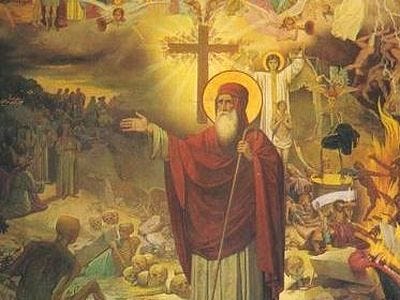The upcoming Old Testament lectionary text for the last Sunday of Lent is from the Leviticus of the prophets, the Book of Ezekiel.
It’s not as random as it might strike you: Matthew reports two earthquakes in his Gospel. Upon the death of Christ on Golgotha, the earth quivered in Easter anticipation, trembling like a woman in labor Three days later the resurrection tips the Richter scale again, Matthew says. This connection between resurrection and earthquakes originates in the graveyard the Lord reveals to the prophet Ezekiel in perhaps the Old Testament’s most important passage.
The Lord brings Ezekiel into the middle of a valley strewn with bones. Dry bones. Bones detached from the bodies to which they once belonged. Bones beyond any possibility of identification or reclamation. The Lord informs Ezekiel that the many anonymous and forgotten bones in this mass tomb are the whole House of Israel. That is, the entirety of the People of God. In other words, you and me.
The hopeless, meaningless valley of the bones is our common fate.
Apart from the mighty work of God.
Easter begins at the grave.
The Lord leads Ezekiel all around the valley of the bones before asking him, “Tell me, mortal, can these bones live?” Ezekiel— he honestly does not know the answer, “O Lord God, only you know.” And the Lord promises Ezekiel that there will be a ra’ash, a rattling of the earth, when the answer to the question comes upon us.
Can these bones live?
Does life have any other point but its own refutation?
The theologian Robert Jenson, writes that all of scripture and the whole of the Christian message can be distilled down to the question God poses to Ezekiel in the boneyard and whether or not God has answered his own question by raising Jesus Christ from the dead.
Easter begins at the grave.
And because Easter begins at the grave so too does the Gospel begin there because the Gospel is God’s answer to his question, “Tell me, mortal, can these bones live?”
I was working double duty both as a pastor and as a hospital chaplain at UVA, where one of my responsibilities was to accompany shocked and freshly grieved strangers to meet the bodies of their loved ones.
One winter night, in the middle of an overnight shift, I was paged to go and meet a mother who’d arrived to see— view— her daughter.
She was waiting at the security desk when I found her.
Her mascara had already streaked down her cheeks and dried in the lines of her face. I noticed she hadn’t put any socks on and she’d put her sweater on backwards.
“I don’t know what she was doing out this time of night,” she kept whispering to herself.
A resident doctor, a med student no older than I was at the time, accompanied us. She’d been the one who’d attended her daughter when the rescue squad brought her in from the accident.
The three of us walked soberly to a tiny, antiseptic room. When the mother saw her daughter, she immediately lost her footing. And then she lost her breath. Then after a long, stretched-out moment, she let out a bone-racking sob. I had my arm around her to comfort her and keep her from falling, but I didn’t say anything.
The med student, though, was clearly unnerved by the rawness of the mother’s grief and by the absence of any words. She put her hand on the mother’s shoulder and looked over at the teenage girl lying on the metal bed with flecks of dried blood not all the way wiped from her hair and forehead and said: “It’s alright. She’s not here. She’s slipped away. That’s just a shell…”
I’d known instantly it was the wrong thing to say, that it rang tinny and false and was completely inadequate for the moment.
Nonetheless, it surprised me when she pushed the doctor away and slapped her hard across the face and cried: “It’s NOT alright. That’s my daughter. She’s not just anything. She’s Beth.”
Listen to this episode with a 7-day free trial
Subscribe to Tamed Cynic to listen to this post and get 7 days of free access to the full post archives.













